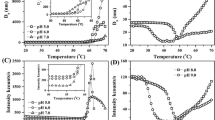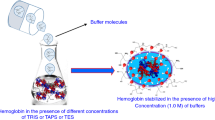Abstract
Using micro-differential scanning calorimetry (μDSC) to probe hemoglobin structural changes, previously unreported large exothermic events have been repeatedly detected at temperatures below the tertiary-to-secondary structural transition temperature (ca. 72 °C), which could be important in understanding protein subunit association. Given the importance of protein–protein interactions and protein solution stability, this event was characterized with respect to concentration and scan rate. This detailed analysis revealed the formation of aggregates that differed in size, appearance, and settling time. While repeat μDSC scans confirmed that this aggregation event was irreversible when samples were heated beyond 55 °C, it was also found that aggregation could be prevented through the addition 0.02 M urea. All evidence points to a significant occurrence of a kinetic pathway that leads to an intermediate aggregation event that is believed to be formed from dissociated hemoglobin subunits.
Graphical Abstract








Similar content being viewed by others
References
Aucoin MG, Jacob D, Chahal PS, Meghrous J, Bernier A, Kamen AA. Virus-like particle and viral vector production using the baculovirus expression vector system/insect cell system (Adeno-associated virus-based products). In: Murhammer DW, editor. Baculovirus and Insect Cell Expression Protocols, vol. 14. 2nd ed. Totowa: Humana Press Inc.; 2007. p. 281–98.
Lunelli L, Zuliani P, Baldini G. Evidence of hemoglobin dissociation. Biopolymers. 1994;34:747–57.
Sasakawa S. Studies on hemoglobin. V. Chromatographic resolution of bovine globin into the valylleucyl and methionyl chains. J Biochem. 1961;49:200–5.
Take T. On the dissociation of hemoglobin under the action of urea. J Biochem. 1961;49:206–10.
Lukin JA, Kontaxis G, Simplaceanu V, Yuan Y, Bax A, Ho C. Quaternary structure of hemoglobin in solution. Proc Natl Acad Sci. 2003;100:517–20.
Fujioka K, Nakajima K, Baba Y, Kagemoto A, Fujishiro R. Enthalpy changes of dissociation of hemoglobin solution. Netsusokutei. 1981;8:91–4.
Gottlieb AJ, Robinson EA, Itano HA. Protein–protein interaction among hemoglobin subunits: a comparison of adult, fetal, and bovine carboxyhemoglobin. Arch Biochem Biophys. 1967;118:693–701.
Beretta S, Chirico G, Arosio D, Baldini G. Role of ionic strength on hemoglobin interparticle interactions and subunit dissociation from light scattering. Macromolecules. 1997;30:7847–55.
Chen H, Sun L, Li G, Zhang SY, Chen HL. Laser-induced time-resolved photoacoustic calorimetry study on photo-dissociation of human and bovine hemoglobin. Biochem Biophys Res Commun. 2004;319:157–62.
Digel I, Maggakis-Kelemen C, Zerlin KF, Linder P, Kasischke N, Kayser P, Porst D, Artmann AT, Artmann GM. Body temperature-related structural transitions of monotremal and human Hemoglobin. Biophys J. 2006;91:3014–21.
Lu L, Wang X, Xian M, Liu Q. Study of bovine hemoglobin dissociation by multiangle laser light-scattering method, Arti. Cells, Blood Subs. Biotechnol. 2004;32:229–41.
Evans WJ, Forlani L, Brunori M, Wyman J, Antonini E. A calorimetric study of the recombination of the isolated α and β chains of human hemoglobin. Biochim Biophys Acta. 1970;214:64–8.
Munishkina LA, Ahmad A, Fink AL, Uversky VN. Guiding protein aggregation with macromolecular crowding. Biochemistry. 2008;47:8993–9006.
Benzwal S, Verma S, Röhm KH, Gursky O. Monitoring protein aggregation during thermal unfolding in circular dichroism experiments. Protein Sci. 2006;15:635–9.
Dzwolak W, Ravindra R, Lendermann J, Winter R. Aggregation of bovine insulin probed by DSC/PPC calorimetry and FTIR spectroscopy. Biochemistry. 2003;42:11347–55.
Bao L, Chatterjee S, Lohmer S, Schomburg D. An irreversible and kinetically controlled process: thermal induced denaturation of l-2-hydroxyisocaproate dehydrogenase from lactobacillus confusus. Protein J. 2007;26:143–51.
Cooper A. Thermodynamics of protein folding and stability. In: Geoffrey A, editor. Protein: a comprehensive treatise. 2nd ed. Denmark: JAI Press Inc; 1999. p. 217–70.
Hayakawa S, Suzuki Y, Nakamura R, Sato Y. Physicochemical characterization of heat-induced soluble aggregates of bovine globin. Agric Chem Biotechnol. 1983;47:395–402.
Damian G, Cânpean V. Conformational changes of bovine hemoglobin at different pH values, studied by ATR FT-IR spectroscopy. Rom J Phys. 2005;15:67–72.
Yan YB, Wang Q, He HW, Zhou HM. Protein thermal aggregation involves distinct regions: sequential events in the heat-induced unfolding and aggregation of hemoglobin. Biophys J. 2003;86:1682–90.
Jansson H, Swenson J. Dynamical changes of hemoglobin and its surrounding water during thermal denaturation as studied by quasielastic neutron scattering and temperature modulated differential scanning calorimetry. J Chem Phys. 2008;128:245104.
Stadler AM, Digel I, Artmann GM, Embs JP, Zaccai G, Büldt G. Hemoglobin dynamics in red blood cells: correlation to body temperature. Biophys J. 2008;95:5449–61.
Hasl RMG, Pauly H. Determination of the specific heat capacity of hemoglobin and methemoglobin-water mixtures using an adiabatic calorimeter. Thermochim Acta. 1978;22:35–339.
Indrawati L, Stroshine RL, G Narsimhan. Low-field NMR, a tool for studying protein aggregation. J Sci Food Agric. 2007;87:2207–16.
Nosworthy NJ, Ginsburg A. Thermal unfolding of dodecameric glutamine synthetase: inhibition of aggregation by urea. Protein Sci. 1997;6:2617–23.
Saito K, Sarai A, Oda M, Azuma T, Kozono H. Thermodynamic analysis of the increased stability of major histocompatibility complex class II molecule I–Ek complexed with an antigenic peptide at an acidic pH. J Biol Chem. 2003;278:14732–8.
Lepock JR, Ritchie KP, Kolios MC, Rodahl AM, Heinz KA, Kruuv J. Influence of transition rates and scan rate on kinetic simulations of differential calorimetry profiles of reversible and irreversible protein denaturation. Biochemistry. 1992;31:12706–12.
Sharma D. Non-isothermal unfolding/denaturing kinetics of egg white protein. J Therm Anal Calorim. 2012;109:1139–43.
Michalik K, Drzazga Z, Michnik A. Calorimetric characterization of 2′,3′-dideoxyinosine waters solution (stability and interaction with human serum albumin). J Therm Anal Calorim. 2008;93:521–6.
Milardi D, Rosa CL, Grasso D. Theoretical basis for differential scanning calorimetric analysis of multimeric proteins. Biophys Chem. 1996;62:95–108.
Rumfeldt JAO, Galvagnion C, Vassall KA, Meiering EM. Conformational stability and folding mechanisms of dimeric proteins. Prog Biophys Mol Biotechnol. 2008;98:61–84.
Sasahara K, Yagi H, Naiki H, Goto Y. Thermal response with exothermic effects of β2-microglobulin amyloid fibrils and fibrillation. J Mol Biol. 2009;389:584–94.
Auton M, Holthauzen LMF, Bolen DW. Anatomy of energetic changes accompanying urea-induced protein denaturation. Proc Natl Acad Sci. 2007;104:15317–22.
Sasahara K, Naiki H, Goto Y. Exothermic effects observed upon heating of β2-microglobulin monomers in the presence of amyloid seeds. Biochemistry. 2006;45:8760–9.
Sanchez-Ruiz JM, Lopez-Lacomba JL, Cortijo M, Mateo PL. Differential scanning calorimetry of the irreversible thermal denaturation of thermolysin. Biochemistry. 1988;27:1648–52.
Relkin P. Reversibility of heat-induced conformational changes and surface exposed hydrophobic clusters of β-lactoglobulin: their role in heat-induced sol-gel state transition. Int J Biol Macromol. 1998;22:59–66.
Risso PH, Borraccetti DM, Araujo C, Hidalgo ME, Gatti CA. Effect of temperature and pH on the aggregation and the surface hydrophobicity of bovine κ-casein. Colloid Polym Sci. 2008;286:1369–78.
Sasahara K, Naiki H, Goto Y. Kinetically controlled thermal response of β2-microglobulin amyloid fibrils. J Mol Biol. 2005;352:700–11.
Michnik A, Drzazga Z, Kluczewska A, Michalik K. Differential scanning microcalorimetry study of the thermal denaturation of haemoglobin. Biophys Chem. 2005;118:92–101.
Bennion BJ, Daggett V. The molecular basis for the chemical denaturation of proteins by urea. Proc Natl Acad Sci. 2003;100:5142–7.
Lee ME, van der Vegt NFA. Does urea denature hydrophobic interactions? J Am Chem Soc. 2006;128:4948–9.
Stumpe MC, Grubmller H. Interaction of urea with amino acids: implications for urea-induced protein denaturation. J. Am Chem Soc. 2007;129:16126–31.
Kamiyama T, Tanaka T, Satoh M, Kimura T. Destabilization of cytochrome c by modified B-cyclodextrin. J Therm Anal Calorim. 2013. doi:10.1007/s10973-013-2969-7.
Acknowledgements
We would like to thank Dr. A. Penlidis for permitting us to use the PSA; Hongyuan He for helping to establish the initial protocols of this work and providing valuable advice in experimental procedures; Joel S. Thompson for his help in running experiments, Yung Priscilla Lai for her editorial comments on this manuscript, and Stanislav Sokolenko for help with figures. This work was jointly supported by NSERC Discovery Grants to KCT and MGA.
Author information
Authors and Affiliations
Corresponding author
Additional information
This work is being submitted posthumously for the first author YeongHo Suh.
Rights and permissions
About this article
Cite this article
Suh, Y., Kim, B.J., Tam, K.C. et al. Detection and characterization of hemoglobin dissociation and aggregation using microcalorimetry. J Therm Anal Calorim 115, 2159–2169 (2014). https://doi.org/10.1007/s10973-013-3424-5
Received:
Accepted:
Published:
Issue Date:
DOI: https://doi.org/10.1007/s10973-013-3424-5




